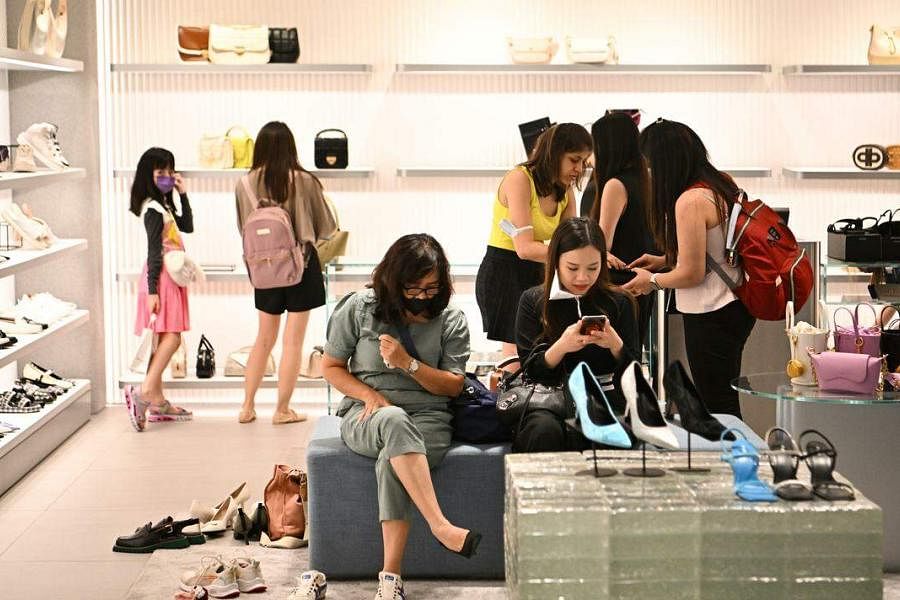
Sharon See
SINGAPORE’S inflation in 2022 came close to official forecast numbers, as price increases in December largely held steady, data from the Monetary Authority of Singapore (MAS) and Ministry of Trade and Industry (MTI) showed on Wednesday (Jan 25).
Headline inflation last year was 6.1 per cent year on year, while core inflation, which excludes accommodation and private transport, came in 4.1 per cent year on year. Both figures were just 0.1 percentage point higher than MAS’ and MTI’s forecast.
In 2021 however, headline inflation was just 2.3 per cent year on year and core inflation, 0.9 per cent year on year.
In December, headline inflation eased to 6.5 per cent year on year, from 6.7 per cent in the previous month, due largely to slower private transport inflation.
Core inflation held steady at 5.1 per cent in December, unchanged from the previous month, as smaller price increases for retail and other goods, and electricity and gas were offset by higher inflation for food and services.
Private-sector economists expected a higher rate of headline inflation at 6.6 per cent, and a lower rate of 5 per cent for core inflation, according to a Bloomberg poll.
Noting that core inflation has remained unchanged for the third straight month, OCBC chief economist Selena Ling said this reinforces her view that core inflation will remain “challenging” in 2023 due to domestic price pressures. This includes the one-percentage-point hike in the goods and services tax to 8 per cent earlier this month.
RHB senior economist Barnabas Gan noted, however, that Singapore’s inflation risks have “dissipated” as momentum slowed into end-2022, even as year-on-year rates remain elevated.
“At this juncture, it is clear that market concerns over rising inflation rates are fading,” he said.
On the whole, consumer price index (CPI) slowed for most categories in December, with the exception of food and services, compared with the previous month.
Private transport inflation fell to 15.5 per cent year on year, from 17.2 per cent, as car and petrol prices rose more gradually.
Accommodation inflation inched down to 4.7 per cent year on year, from 4.8 per cent, as housing rents rose at a slower pace.Price increases for retail and other goods slowed to 2.8 per cent year on year, down from 3.3 per cent in November. This was due to a fall in the cost of telecommunication equipment and personal effects as well as smaller increases in the prices of clothing and footwear, and household durables, said MAS and MTI.
Electricity and gas inflation dipped to 16.5 per cent year on year, from 16.7 per cent, due to a smaller increase in electricity prices.Bucking the trend was services inflation, which edged up 0.1 percentage point to 3.7 per cent year on year.
MAS and MTI attributed this to a larger increase in the cost of holiday expenses. Telecommunication services fees fell at a slower pace while tuition and other fees rose more steeply, they added.Price increases for food also picked up, hitting 7.5 per cent year on year, from 7.3 per cent in November, due to higher inflation for non-cooked food.
For 2023, the authorities have kept their inflation outlook the same, with headline inflation expected to average 5.5 to 6.5 per cent and core inflation, 3.5 to 4.5 per cent.
“Overall, as accumulated costs pass through global value chains, Singapore’s imported inflation is expected to remain firm for some time,” said the authorities.
They noted that although electricity tariffs have come down from their peak in the third quarter, the cost of utilities is likely to remain elevated, with firms expected to pass through accumulated costs to consumers amid resilient demand.
OCBC’s Ling said many other economies may see a “faster normalisation” of inflationary pressures due to relatively stable energy prices and high base effects from last year. Singapore is likely to experience “higher-than-normal” headline and core inflation in 2023 as inflation drivers have “rotated from external to domestic price drivers”.
However, Maybank’s economists Chua Hak Bin and Lee Ju Ye believe China’s reopening will complicate the inflation outlook and likely drive energy and other commodity prices higher.
“The reopening may also fan China’s inflation, mirroring the experience of other countries including the US, Europe, Australia and even Japan, due to structural shifts in the labour market as workers may be slow to return,” said the Maybank economists. “This may show up in higher imported inflation for Singapore given the weight of China-related imports. China’s reopening and revenge travel will also power travel and hospitality costs higher.”
Separately, the highest 20 per cent income group saw the largest increase in inflation, excluding owner-occupied accommodation (OOA), in the second half of 2022, among the three household income group classifications used by the government.
This is according to a separate release by the Department of Statistics Singapore (SingStat) detailing the impact of inflation on households.
“This was because the higher costs of cars, petrol and holiday expenses had a larger impact on its CPI as compared to that of the other income groups given that these items constituted a bigger share of its expenditure basket,” SingStat said.
Accordingly, the highest 20 per cent income group saw inflation excluding imputed rentals on OOA increase 8.1 per cent year on year in H2; the middle 60 per cent income group experienced a 7.1 per cent increase in CPI; and the lowest 20 per cent income group had a 5.9 per cent increase in inflation.
For the full year, the figure is 7.3 per cent for the highest income group, 6.1 per cent for the middle income group, and 5 per cent for the lowest income group.
